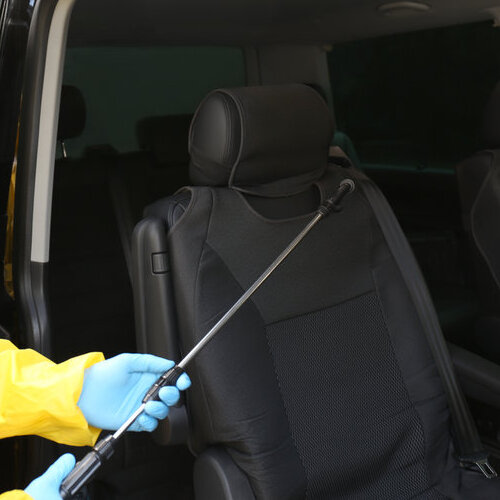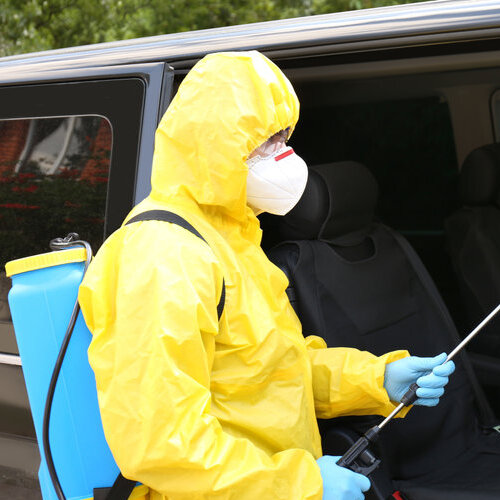
Understanding Vehicle Decontamination
Vehicle decontamination sounds serious, doesn’t it? So, what is car contamination? It sounds serious because it is serious. COVID-19 brought many things to light for the everyday person, including how full of bacteria and germs our vehicles can get on the inside. Fortunately for us, vehicle decontamination is something that our First Responders are trained to know about and how to go about this process.
Ambulances especially are held to a strict guideline for cleaning and disinfecting at the beginning of a shift, after transporting patients, and end of a shift. The ambulance is one place where the germs that transmitted the coronavirus could easily have been transferred from one patient to the next if not for proper and thorough vehicle decontamination.
Consistent and correct cleaning and decontaminating steps included having adequate ventilation as crews used the chemicals needed for vehicle decontamination. Crews were also trained to use any PPE protective gear as they decontaminated their units. The areas that are included in this decontamination process are:
- Hard non-porous interior surfaces. The arm rest, door handles and grab bars, seats and seat buckles, controls, and any surface that appeared dirty was to be disinfected.
- Soft and/or porous surfaces such as fabric-covered seats.
- Electronic surfaces such as tablets and touch screens, communication instruments, medical devices, etc.
- Disposable PPE materials like gloves, gowns, masks were to be disposed of properly.
- Crew members were instructed to wash hands for 20 seconds with sanitizing soap.
- Cloth items like stretch sheets and blankets are to be immediately removed and laundered.
Other times vehicle decontamination is needed is on the exterior to remove biohazards like radioactive exposure and after a fire.
What does decontamination remove?
Vehicle decontamination in the area of first responder use is a process of removing or destroying infectious agents and other contaminants. It is a process that keeps susceptible sites from becoming contaminated by a site that has been exposed to sufficient quantities of matter that can initiate infection and harmful responses.
What is car paint contamination?
With this bit of education on additional responsibilities that First Responders have, it should be noted there are other types of vehicle decontamination. Like the exterior of a car for painting purposes. Like paint contaminants from bugs, grime, road salt, and other airborne matters that get stuck on the exterior of a car or other vehicles and in the paint.
Most of these things will wash off with a short period of exposure. However, some others will bury themselves into the surface and remain, or if the vehicle isn’t washed periodically, can slowly degrade the clear coating that manufacturers apply to cars.
For a car to be repainted, vehicle decontamination is needed. This will assure the new paint coating will adhere without issue. To determine if the vehicle decontamination process is needed, rub the surface of the car. A bumpy, rough feel is an indication the process is needed. So if vehicle decontamination is needed, what do you use to decontaminate a car?
Clay bar treatment is something that most people have never heard of, much less know how to use for vehicle decontamination. To get dirt and other particles removed completely, a clay bar is a necessity in the auto paint and body industry. Clay bars are durable and elastic, allowing tough substances like brake dust, road salt, and other contaminants that can pierce into glass, metal, and paint. There are three types of clay bar:
- Fine Clay Bar: The softer type that is easy to use and ideal for removing any small contaminants.
- Medium Clay Bar: This clay bar is for tougher contamination like tree sap. A more abrasive grade with a firm consistency and higher density. It removes impurities by scrubbing them away. This includes any industrial fallout and overspray.
- Heavy Clay Bar: Removes the tougher overspray and stubborn contaminants and should only be used by an experienced professional. Professional auto body workers will use it on glass and metal wheels.
How do you fully decontaminate a car?
Professional auto body technicians that are doing full vehicle decontamination for paint and bodywork will follow these steps:
- One: Wash the car exterior thoroughly.
- Two: Next, they will begin the clay bar process, dividing the car surface into 2-foot sections.
- Three: One 2-foot section at a time, they will spray a special lubricant on the wet surface. A wet surface is required to avoid damaging the paint.
- Four: The clay bar is rubbed in using small, circular motions until it is smoothing running over the surface.
- Five: The area that has a clay bar applied is wiped down with a microfiber towel. If any residue is left behind, the technician will spray a lubricant over it then using a clean microfiber towel, wipe it down again.
- Six: Once the clay bar process is completed, the technician will polish and wax the vehicle. This creates a glossy finish, protects it, and extends the paint’s lifespan.
The process of vehicle decontamination is difficult, hard work. For a properly clean vehicle, car decontamination will remove any tough blemishes so the exterior beauty is restored. Afterward, the technician will offer you a car decontamination kit. This can be used to help keep the paint job in ideal condition with products that easily remove paint-marring contaminants, like asphalt, bugs, iron, and tar.
Is car paint decontamination necessary?
For a new paint job on a car or other vehicle to adhere and shine, yes, absolutely. For an emergency vehicle, decontamination is important to keep the community safe from biohazard, bacteria, and germs spreading.

Wrapping It Up
Vehicle decontamination is important, whether it is for the safety of the public, the adherence of a new paint job, or keeping an existing paint job looking good. So, how often should you decontaminate a car?
As we discussed in the beginning, for an emergency vehicle, decontamination is required at the beginning and end of each shift, as well as after each transportation and service call. For the purpose of maintaining a vehicle’s paint job, the basic rule of thumb is every two weeks.
Many car owners will wash their vehicles once a week, or even more. Any time your car has been driving on roads covered with ice or has seen a lot of highway time, vehicle decontamination should be done to remove the asphalt, bugs, and tar.

